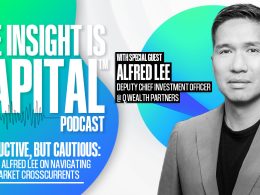Should You Grow Your Financial Advisory Practice?
by Commonwealth Financial Network
 Looking around the industry, you’ll see a variety of attitudes toward business growth among your fellow advisors. If you’re in one camp, you likely maintain a relentless focus on top-line revenue growth, expanding your client base, going upstream to higher-net-worth clients, providing additional services, acquiring another practice, or recruiting new advisors to increase capacity and scale. On the other hand, having reached a certain level of success, perhaps you’ve decided to put business growth on the back burner to focus instead on personal growth. But what is the best decision for your business?
Looking around the industry, you’ll see a variety of attitudes toward business growth among your fellow advisors. If you’re in one camp, you likely maintain a relentless focus on top-line revenue growth, expanding your client base, going upstream to higher-net-worth clients, providing additional services, acquiring another practice, or recruiting new advisors to increase capacity and scale. On the other hand, having reached a certain level of success, perhaps you’ve decided to put business growth on the back burner to focus instead on personal growth. But what is the best decision for your business?
Whether to grow your financial advisory practice—or to disengage from it—is a decision ultimately faced by most successful advisors. To help you determine what’s right for you, let’s explore the five stages of business growth, as well as factors that may come into play when making this decision.
In their classic article "The Five Stages of Small Business Growth," Neil C. Churchill and Virginia L. Lewis describe five stages in the evolution of small businesses:
Stage 1: Existence. The business owner dedicates himself or herself to getting customers and delivering service to clients.
Stage 2: Survival. After proving that the business is viable, the owner focuses on getting enough cash to break even and then to finance sufficient growth to be competitive in the industry.
Stage 3: Success. At this point, the owner must decide whether to (1) exploit the company’s accomplishment and continue to grow or (2) keep the business stable and profitable in order to support the owner’s partial disengagement from the company.
For those of you in this stage, Churchill and Lewis point out that either of the options noted above is feasible as long as your business is generating sufficient cash. Here, if you choose to disengage rather than to grow, the strategy becomes preserving the status quo. With the right systems and personnel in place, and barring any disruption to cash flow, your business can remain at this stage indefinitely. At some point, it may be sold, merged profitably, or stimulated into the growth mode.
Stage 4: Takeoff. If the owner chooses the first approach in the Success phase, he or she expands the business by delegating more tasks to others and deploying cash to finance additional (typically rapid) growth.
Stage 5: Maturity. The owner’s challenge is to harness the business’s financial gains while maintaining entrepreneurial spirit throughout the organization.
Churchill and Lewis also identify eight key factors that determine the ultimate success or failure of a business. Four relate to the business itself:
- Financial resources
- Personnel resources
- Systems resources
- Business resources (e.g., client retention and market share penetration)
The other four factors are derived from the business owner:
- The owner’s goals
- Operational abilities
- Managerial abilities
- Strategic abilities
The importance of each factor varies depending on where your firm is in the development process. That is, are you a baby boomer advisor or someone who is just starting out? Your personal goals and financial resources are essential in the first stage, whereas business systems and your strategic abilities assume greater importance at business maturity.
If you’re a baby boomer advisor, you’ve likely built a practice that falls firmly in the Success stage. In general, you’ve endured the hard times of Existence and Survival, arriving at a point of economic health where the practice yields at least average profits. You may also be a solo practitioner, filling the three-pronged role of advisor/owner/rainmaker for your firm.
Some of you may view your firms as a platform for ongoing business growth. Others have (consciously or unconsciously) disengaged, shifting your energy to personal interests outside the business. Again, as long as there is sufficient cash and internal delegation, either option can work. But there are certain other considerations that may come into play.
Intent to work indefinitely. If you’re like many boomers, you might be resistant to putting a succession plan in place. You’d like to “work forever” or as long as you’re able. But external factors may put some wrinkles in your plans. Since sustaining the disengagement model depends on steady cash flow, it’s important to forecast future revenue accurately. Think about the combined impact of the attrition of a few clients, a large number of clients in the distribution phase of their financial lives, and the reality that aging clients are passing away. All directly affect revenue (i.e., the key factor in remaining in the Success stage versus reverting to Survival mode).
Attracting new clients. It’s easy to think you’ll simply replace disappearing business with new clients. Well, think again. The oldest baby boomers are approaching 68. Gen X investors are now entering their 50s. Are these investors more likely to seek an advisor nearing 70 or another Gen Xer in the industry? The hard truth is that attracting new clients may become increasingly challenging over time.
“I hate that management stuff.” You’ve achieved success in the industry thanks to your excellent professional skills. But long-term growth and viability require a myriad of business capabilities. Specifically, you must question whether you’ve developed the management skills that are just as critical to the growing enterprise as your professional expertise, if not more so.
Leaving a legacy. Many advisors talk about building an enduring firm. If you’re a solo, however, the more likely scenario is selling your practice. Ensembles tend to sell to other ensembles but not to solos, and solos sell to either solos or ensembles. So, if you truly want to build a legacy firm, you cannot choose to disengage. Instead, your focus should be on continued growth of the business and advancement to the Takeoff and Maturity stages.
If you’re on the other end of the career spectrum, you’re a next-gen advisor who will likely buy a practice already at the Success stage. In many cases, you will combine the new practice with a firm you have taken through the Existence and Survival stages. When you reach the Success crossroads, which you’re likely to do at an earlier age than the previous generation, you will face the same hard decision: Will you reinvest your resources in the firm, likely taking on additional risk to finance future growth, or will you redirect your time, energy, and resources elsewhere?
If you choose continued growth, you will need to be armed with a variety of well-honed skills. These include:
- Embracing managerial responsibilities, especially those related to managing people
- Having access not just to financial resources but also to borrowing power
- Taking advantage of highly sophisticated technology, which will likely encompass business management functions as well as financial planning and investment management
- Understanding the impact of retention and niche-specific growth on expanding market share
- Thinking strategically to match the needs of the firm with personal goals
Be aware, there will be challenges awaiting you in the Maturity stage, when you must take care to preserve both your firm’s financial gains and its entrepreneurial spirit. As Churchill and Lewis note, if either is lost, your practice will ossify.
Going forward, it seems likely that the industry will be shaped by those who choose to bring already successful firms to the Takeoff stage, potentially evolving into a big business. Given the trajectory of other professional industries (e.g., medicine and dentistry), one can imagine a future in which the staff CFP delivers financial advice to clients, while the business owner manages the firm.
Although your personal vision of the future may differ, it’s essential for you to make strategic decisions regarding the importance of growth to your firm. Whether you’re a baby boomer or a next-gen advisor, the choice to choose to grow or partially disengage should be one that is consciously made.
How do you envision the future of the industry and your practice? Do you plan on bringing your firm to the Takeoff stage? Please share your thoughts with us below.
Commonwealth Financial Network is the nation’s largest privately held independent broker/dealer-RIA. This post originally appeared on Commonwealth Independent Advisor, the firm’s corporate blog.
Copyright © Commonwealth Financial Network

















